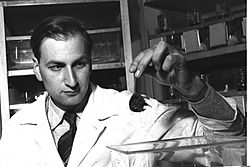Leo Sachs facts for kids
Quick facts for kids
Leo Sachs
|
|
|---|---|

Leo Sachs, 1955
|
|
| Born | 14 October 1924 Leipzig, Saxony
|
| Died | 12 December 2013 (aged 89) |
| Nationality | Israeli |
| Scientific career | |
| Fields | Molecular biology |
Leo Sachs (born October 14, 1924 – died December 12, 2013) was a famous scientist. He was born in Germany but became an Israeli molecular biologist and cancer researcher. He moved to the United Kingdom in 1933 and later to Israel in 1952. In Israel, he worked at the Weizmann Institute of Science.
Contents
About Leo Sachs
Leo Sachs and his family moved to Britain in 1933 because of the political situation in Germany. He earned a science degree from the University of Wales in 1952. Before that, he dreamed of helping to build a community in Palestine. He even worked as a farm laborer for two years. But it was hard to move to Palestine then.
So, Sachs started studying plants at the University of Wales. He became very interested in genetics and how living things develop. He finished his PhD in genetics at Cambridge University in 1951.
Moving to Israel and Early Research
When Leo Sachs moved to Israel, he used his skills as a geneticist. He joined the Weizmann Institute. At that time, there were no animal studies at the Institute. So, Sachs started researching human amniotic fluid. This fluid surrounds a baby in the womb. He believed it contained cells that could tell us about the baby.
His research proved he was right! These cells could show the baby's gender and other important genetic details. Sachs's work became the foundation for amniocentesis. This is a common test used today to check for diseases in unborn babies.
Discovering How Cells Grow
Later, Sachs got his own lab and started working with mice. He wanted to understand what controls normal growth in the body. He also wanted to know what happens when growth goes wrong, like in cancer. Why do cancer cells grow out of control?
He focused on blood stem cells. These are special cells in bone marrow. They make about 200 billion new blood cells every day. In 1963, Sachs created the first way to grow and study different types of normal blood cells in a lab.
Using this method, he found a group of proteins. These proteins are very important for controlling how blood cells develop. They were later named colony stimulating factors (CSF) and interleukins. One of these CSF proteins is now used worldwide. It helps cancer patients make more infection-fighting white blood cells. It also helps make bone marrow transplants more successful.
Reversing Cancer Cells
Sachs also showed something amazing: that cancer cells could be made to act normal again. He found that the proteins he discovered, along with other compounds, could guide leukemia cells back to the right path. They could make these abnormal cells develop into normal, mature cells.
This approach is now a standard treatment for a type of leukemia. It uses a medicine called retinoic acid combined with chemotherapy. This treatment has greatly improved how many people survive this disease.
At the Weizmann Institute, he started a new section for genetics and virology. He led the genetics department for 27 years, from 1962 to 1989. He also served as the dean of the biology faculty from 1974 to 1979.
Amazing Achievements and Awards
Leo Sachs received many important awards for his scientific work:
- In 1965, he became a Member of the European Molecular Biology Organisation.
- In 1972, he won the Israel Prize for natural sciences. This is one of Israel's highest honors.
- In 1975, he became a Member of the Israel Academy of Sciences and Humanities.
- In 1977, he received the Rothschild Prize in the Biological Sciences.
- In 1980, he won the Wolf Prize in Medicine. He was the first Israeli scientist to win this award. He received it for his work on how normal and cancer cells are controlled.
- In 1983, he was awarded the Bristol-Myers Squibb Award for Distinguished Achievement in Cancer Research.
- In 1985, he received an honorary doctorate from Bordeaux University in France.
- In 1986, he won The Royal Society Wellcome Foundation Prize.
- In 1989, he was awarded the Alfred P. Sloan Prize.
- In 1995, he was elected as a Foreign Associate to the U.S. National Academy of Sciences (NAS).
- In 1996, he received the Ot Hanagid (Medal of the Governor) award. This award recognized his pioneering work in cancer research. It highlighted his discovery of proteins like colony-stimulating factors. It also noted his early research on using amniotic fluid for prenatal diagnosis.
- In 1997, he was elected a Fellow of the Royal Society.
- In 1998, he became a Foreign Member of the Academia Europaea.
- In 1999, he was made an Honorary Fellow of the University of Wales, Bangor.
- In 2000, he gave the Ham-Wasserman Lecture for the American Society of Hematology.
- In 2001, he received an Honorary Life Membership Award from the International Cytokine Society.
- In 2002, he was awarded the Emet Prize for Life Sciences, Medicine and Genetics.
See also
- List of Israel Prize recipients

